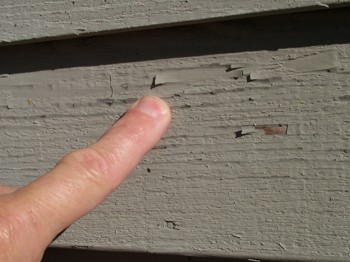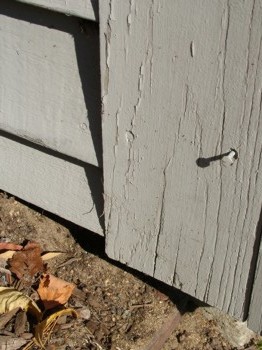Solid Stain
DEAR TIM: I visited a national-brand paint store and talked with an employee about solid stain. I told him I wanted a solid color on my home, but that I didn’t want to paint my home because it would peel eventually. The salesman said I should use solid color stain on my home. I bought ten gallons of a custom color on his recommendation and took it home. When I opened up the first can, I was shocked to see how thick the product was. It was full bodied, just like paint. The label says it’s non-returnable because it’s a custom color. Will it be a mistake to apply this to my home? What can/should I do? Bobbie B., Edison, NJ
DEAR BOBBIE: The first thing I would do would be go back to that paint store and discuss the situation with the store manager. I feel you got very bad advice. With all due respect, the employee who serviced you is perhaps one of the lowest-paid employees in the entire company. I doubt he has a chemistry background. Furthermore, my guess is that this employee hasn’t had extensive training as to the difference between film-forming coatings and penetrating wood stains. You wanted to buy a product that would not peel. What you were sold was a paint that’s marketed as a stain. Ask for a full refund.

This association clubhouse has low-quality paint on it. It was sold as a solid stain. PHOTO CREDIT: Tim Carter
Let me share a story that just happened to me. I’m convinced that it will help you solve your problem. This past weekend I attended an association meeting in the community where I live in New Hampshire. It’s called Waldron Bay, and has a stunning clubhouse covered with lap cedar siding on the shore of Lake Winnisquam. Years ago, the wood siding on the clubhouse was treated with, what I believe to be, an acrylic solid stain. It’s peeling in places, and needs to be recoated.

You can clearly see the low-quality paint - sold as stain - peeling. It never penetrated into the pores of the wood siding. PHOTO CREDIT: Tim Carter
I was asked a year ago to write a specification for painters to follow so they could give us a bid. The association board wanted the clubhouse to be a solid color just like your home. I discovered years ago that some paint companies play a little shell game with their products as a marketing gimmick so that you buy a product thinking you have something else entirely. It even happened to me 25 years ago on my own home.
Yes, I went into a national paint store 25 years ago asking for the same product you wanted. I didn’t want paint that would peel, so the employee told me to use a solid color stain that would never peel. Guess what? I can show you many places on that house where the “stain” is peeling. In your head and mine, you equate the word stain with a colored liquid that soaks into the pores of wood and doesn’t lay on the surface of the wood. Thus, it can’t peel. Imagine if you label a thin or even thick-bodied film-forming liquid as a stain and sell that? Yes, you’ll confuse and trick many people.

PHOTO CREDIT: Tim Carter
These powerful mind tricks happened to our association board this weekend and even many of the homeowners who attended the meeting. The president of the association visited a local paint store and got the same advice you did. The association members voted to coat the exterior of the clubhouse with a solid color stain that in reality is a lower-quality paint. In a spirited debate, I was defending my specification to use the best paint available that’s made in the USA.
When the votes were counted, there was one person in the audience who voted against the motion to use solid color stain - it was me. The sad thing is that for the amount needed to paint our clubhouse, there was only a difference in price of less that $180 between the solid color stain and the best paint on the market. Oh well, you can aim a hose into a person’s mouth, but you can’t make them swallow.
If you open can after can of solid stains and they have the consistency of paint, that’s what they are - paint. Paint is a film-forming coating. It’s supposed to lay on the surface of what’s being painted and bond to it mechanically and sometimes chemically. Paint doesn’t soak completely into wood pores taking the tiny color pigments with it. Thin-bodied stains that have the consistency of water are formulated to do just that.
Since you want your house to be a solid color, you’re forced to use a paint. There’s nothing wrong with that. But to minimize future peeling, you want to purchase the absolute best paint on the market. The chemistry of paint is nearly identical to many adhesives. Think about it - glues or adhesives are formulated to stick to things or bond two things together. Paint is simply glue with color in it. Great paints stick very well to skin, wood, metal, clothes, rugs, etc. I’m sure you know all about that if you’ve spilled any!
You want to bond the paint film to the wood, so you want to buy the best glue (paint) made and follow the directions on the label to the letter to ensure it will stick for a very long time to the wood. The best thing you can do is wash the outside of your home with soap and water by hand to remove any and all dirt that will interfere with the ability of the glue to stick to your home.
The Federal Trade Commission is tasked with eliminating deceptive trade or advertising practices. It’s my honest opinion that this is one area where strict definitions of words cause a problem. Think about it for a moment.
If you want a piece of wood to have no color change, you coat it with a clear urethane or varnish. If you want to change the color of the wood, you apply a stain. I can live with that. So the paint companies can say with all validity in a hearing that when you use a solid stain, you’re indeed changing the color of the wood. Once again, that’s the truth.
But the disconnect happens because transparent penetrating wood stains have been sold for years as a non-peeling product because, in fact, they don’t peel. Thus consumers equate stain with no peeling. It’s a very gray area. Don’t be fooled.
This column was SO GOOD that I shared with the 31,000 subscribers who read my August 2, 2020 newsletter.
Column 800
12 Responses to Solid Stain